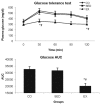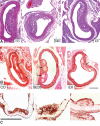The anti-inflammatory effects of exercise training promote atherosclerotic plaque stabilization in apolipoprotein E knockout mice with diabetic atherosclerosis
- PMID: 23549462
- PMCID: PMC3683610
- DOI: 10.4081/ejh.2013.e3
The anti-inflammatory effects of exercise training promote atherosclerotic plaque stabilization in apolipoprotein E knockout mice with diabetic atherosclerosis
Abstract
Physical exercise is the cornerstone of cardiovascular disease treatment. The present study investigated whether exercise training affects atherosclerotic plaque composition through the modification of inflammatory-related pathways in apolipoprotein E knockout (apoE(-/-)) mice with diabetic atherosclerosis. Forty-five male apoE(-/-) mice were randomized into three equivalent (n=15) groups: control (CO), sedentary (SED), and exercise (EX). Diabetes was induced by streptozotocin administration. High-fat diet was administered to all groups for 12 weeks. Afterwards, CO mice were euthanatized, while the sedentary and exercise groups continued high-fat diet for 6 additional weeks. Exercising mice followed an exercise program on motorized-treadmill (5 times/week, 60 min/session). Then, blood samples and atherosclerotic plaques in the aortic root were examined. A considerable (P<0.001) regression of the atherosclerotic lesions was observed in the exercise group (180.339 ± 75.613 x10(3)μm(2)) compared to the control (325.485 ± 72.302 x10(3)μm(2)) and sedentary (340.188 ± 159.108 x 10(3)μm(2)) groups. We found decreased macrophages, matrix metalloproteinase-2 (MMP-2), MMP-3, MMP-8 and interleukin-6 (IL-6) concentrations (P<0.05) in the atherosclerotic plaques of the exercise group. Compared to both control and sedentary groups, exercise training significantly increased collagen (P<0.05), elastin (P<0.001), and tissue inhibitor of matrix metalloproteinase-2 (TIMP-2) (P<0.001) content in the atherosclerotic plaques. Those effects paralleled with increased fibrous cap thickness and less internal elastic lamina ruptures after exercise training (P<0.05), while body-weight and lipid parameters did not significantly change. Plasma MMP-2 and MMP-3 concentrations in atherosclerotic tissues followed a similar trend. From our study we can conclude that exercise training reduces and stabilizes atherosclerotic lesions in apoE-/- mice with diabetic atherosclerosis. A favorable modification of the inflammatory regulators seems to explain those beneficial effects.
Conflict of interest statement
Conflict of interests: the authors declare no conflict of interests.
Figures




Similar articles
-
The complementary effects of atorvastatin and exercise treatment on the composition and stability of the atherosclerotic plaques in ApoE knockout mice.PLoS One. 2014 Sep 29;9(9):e108240. doi: 10.1371/journal.pone.0108240. eCollection 2014. PLoS One. 2014. PMID: 25264981 Free PMC article. Clinical Trial.
-
Exercise training inhibits atherosclerosis progression and reduces VE-cadherin levels within atherosclerotic plaques in hypercholesterolemic mice.Biochem Biophys Res Commun. 2022 Oct 1;623:39-43. doi: 10.1016/j.bbrc.2022.07.039. Epub 2022 Jul 14. Biochem Biophys Res Commun. 2022. PMID: 35870260
-
The role of exercise training and the endocannabinoid system in atherosclerotic plaque burden and composition in Apo-E-deficient mice.Hellenic J Cardiol. 2016 Nov-Dec;57(6):417-425. doi: 10.1016/j.hjc.2016.11.013. Epub 2016 Nov 16. Hellenic J Cardiol. 2016. PMID: 28254386
-
Crocus sativus L. aqueous extract reduces atherogenesis, increases atherosclerotic plaque stability and improves glucose control in diabetic atherosclerotic animals.Atherosclerosis. 2018 Jan;268:207-214. doi: 10.1016/j.atherosclerosis.2017.10.032. Epub 2017 Nov 1. Atherosclerosis. 2018. PMID: 29128090
-
Impact of Non-Pharmacological Interventions on the Mechanisms of Atherosclerosis.Int J Mol Sci. 2022 Aug 13;23(16):9097. doi: 10.3390/ijms23169097. Int J Mol Sci. 2022. PMID: 36012362 Free PMC article. Review.
Cited by
-
Aerobic Exercise Training Reduces Atherogenesis Induced by Low-Sodium Diet in LDL Receptor Knockout Mice.Antioxidants (Basel). 2022 Oct 13;11(10):2023. doi: 10.3390/antiox11102023. Antioxidants (Basel). 2022. PMID: 36290746 Free PMC article.
-
High density lipoprotein and metabolic disease: Potential benefits of restoring its functional properties.Mol Metab. 2016 Mar 18;5(5):321-327. doi: 10.1016/j.molmet.2016.03.001. eCollection 2016 May. Mol Metab. 2016. PMID: 27110484 Free PMC article. Review.
-
Exercise Training Attenuates the Development of Cardiac Autonomic Dysfunction in Diabetic Rats.In Vivo. 2018 Nov-Dec;32(6):1433-1441. doi: 10.21873/invivo.11396. In Vivo. 2018. PMID: 30348698 Free PMC article.
-
The Effects of Exercise on Plaque Volume and Composition in a Mouse Model of Early and Late Life Atherosclerosis.Front Cardiovasc Med. 2022 Mar 28;9:837371. doi: 10.3389/fcvm.2022.837371. eCollection 2022. Front Cardiovasc Med. 2022. PMID: 35419434 Free PMC article.
-
Do Changes in Innate Immunity Underlie the Cardiovascular Benefits of Exercise?Front Cardiovasc Med. 2019 May 29;6:70. doi: 10.3389/fcvm.2019.00070. eCollection 2019. Front Cardiovasc Med. 2019. PMID: 31192231 Free PMC article. No abstract available.
References
-
- Nanni S, Melandri G, Hanemaaijer R, Cervi V, Tomasi L, Altimari A, et al. Matrix metalloproteinases in premature coronary atherosclerosis: influence of inhibitors, inflammation, and genetic polymorphisms. Transl Res. 2007;149:137–44. - PubMed
-
- Buse JB, Ginsberg HN, Bakris GL, Clark NG, Costa F, Eckel R, et al. Primary prevention of cardiovascular diseases in people with diabetes mellitus: a scientific statement from the American Heart Association and the American Diabetes Association. Circulation. 2007;115:114–26. - PubMed
-
- Kadoglou NP, Iliadis F, Liapis CD. Exercise and carotid atherosclerosis. Eur J Vasc Endovasc. 2008;35:264–72. - PubMed
-
- Kadoglou NP, Iliadis F, Angelopoulou N, Sailer N, Fotiadis G, Voliotis K, et al. Cardiorespiratory capacity is associated with favourable cardiovascular risk profile in patients with Type 2 diabetes. J Diabetes Complicat. 2009;23:160–6. - PubMed
Publication types
MeSH terms
Substances
LinkOut - more resources
Full Text Sources
Other Literature Sources
Research Materials
Miscellaneous

